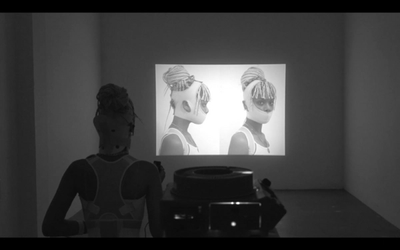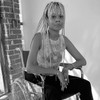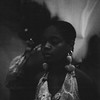Eyebeam Hands Over Authority of its Flagship Residency to Artists with the Launch of The Democracy Machine

Panteha Abareshi, still from METHODS OF CARE FOR THE PRECARIOUS BODY, (2021). Courtesy of the artist.





News Release
eyebeam.org
@eyebeamnyc #thedemocracymachine #fractalfellowships
Brent Foster Jones, (917) 280-6217, press@eyebeam.org
“What are the ideals we should be striving for within democracy and how do we elevate the needs of the many when digital tools are invented by the few?”
-Roderick Schrock, Eyebeam
Eyebeam Hands Over Authority of its Flagship Residency to Artists with the Launch of The Democracy Machine
∙ A radical cycle of support for socially concerned artists will award $1.5 million to 75 artists, by artists
∙ An initial cohort of Black, disabled, and Indigenous artists will create a three year blueprint of art and activism to unlock self-governance and democracy
Brooklyn, NY, October 28, 2021 —Eyebeam, now an online/offline catalyst and incubator, announced today it has handed over authority of its flagship digital residency to artists for the next three years, following the selection of an initial cohort who will create a dynamic, evolving blueprint and strategy to unlock artist-led invention in the areas of self-governance, technology, and democracy. A total of 75 artists will receive $1.5 million as part of The Democracy Machine, a radical, ambitious cycle of trans-disciplinary art and activism guided by artists. For impact, the cycle will be complemented by a new coalition of organizations invested in unleashing the positive potentials of emerging technologies through art and activism, such as the Center for Artistic Activism and Data & Society. The announcement follows Eyebeam’s decision earlier this year to shed its physical residency, de-center its authority, and operate in a distributed, digital first format that emphasizes network and community building and social justice; this fall Eyebeam will launch an experimental online space to present the work of the cohort and host a wide range of presentations and programs, ‘Open. Eyebeam.’ The space will also be a key into new possibilities for hybrid digital and in-person gatherings through future iterations. The Democracy Machine is currently funded with new investments of $1.1 million from The Andrew W. Mellon Foundation and Ford Foundation, among others.
“Can democracy exist and what does it look like?” said Roderick Schrock, executive director of Eyebeam and a curator. In 2020, he and the staff of Eyebeam launched an initiative to fund artists working towards a more equitable and humane digital realm, Rapid Response for a Better Digital Future. “That question,” he said, “is the starting point and modus operandi of The Democracy Machine, a harnessing of the power of art to help societies combat technologically-fueled populist ideologies. It is our belief that artist-created space for imagination and contemplation, allowing for public engagement with the complexities of our time, is a necessary, partial antidote.”
“Inherent to The Democracy Machine is an extraordinary new model of artists guiding and championing other artists,” said Elizabeth Alexander, President of The Andrew W. Mellon Foundation. “We’re thrilled to support this inventive approach to artistic self-governance and democracy, and we look forward to seeing what the initial cohort of artists creates.”
Background
Announced today, a cohort of five artists chosen through a global nominating process will each receive $20,000 along with profound professional development opportunities. These artists will create a dynamic blueprint and search criteria to identify three additional cohorts of artists from around the world committed to exploring new forms of self-governance and their relationships to democracy for eight month fellowships. Eyebeam limited the first cohort to Black, disabled, and Indigenous artists. Black artists are contending with digital cultural healing and online wellness, an under-resourced and overlooked priority in the technology and healthcare industries; disabled artists are considering digital spaces that need the perspectives of the disability population, who have been radically inventive due to necessity; and Indigenous artists are persisting in their efforts to include indigenous voices in all forms of technology and digital spaces to achieve equity for their communities. Eyebeam also acknowledges a reality that, according to the U.N., an estimated 3.8 billion people live totally offline or have blocked access to the Internet. The initiative asks, How might artists circumnavigate state-sanctioned censorship, surveillance, and repression and work towards global connectivity and egalitarian access to digital space?
Added Schrock: “We are uniting all of Eyebeam’s programs around The Democracy Machine, so that we can promote justice and poeticize culture. As the ‘fractal’ fellowships unfold, we will make the artists’ work freely available to the public and we will launch youth initiatives that engage the ideas and projects of these visionary artists.”
“A future that benefits from the work of many artists”
The cohort of artists produce work in a variety of disciplines, mediums, and milieus, from addressing the objectification and dissection of the chronically ill body, to rewriting history from more inclusive perspectives, to reaching Black community members who are working outside of the fields of new media and technology in order to better understand how the experiences of Black people are mediated by technology and its social phenomena.
Panteha Abareshi is a chronically ill, disabled artist who lives and works in Los Angeles. Their trans-disciplinary practice spanning sculpture, video, and performance explores accessibility in abstract, radical terms and is informed by debilitating pain, bodily deterioration, and their own experiences of marginalization, erasure, and violence “lost on the average able-bodied individual.” Neta Bomani is a Brooklyn-based teacher, computer programmer, Black feminist scholar, zine maker, and abolitionist whose work questions the notion of freedom. Her anti-art practice is informed by her interest in “parsing information and histories while making things by hand with human and non-human computers.” She makes work for an intergenerational audience of Black people who are “engaged in thinking more critically about their Blackness” in order to engage them in a “conversation about technology and how socio-technological phenomena mediate our subjective experiences as Black people.” Sebastián Calfuqueo , pictured, is a Mapuche artist and activist and part of the Mapuche collective Rangiñtulewfü and Yene Revista whose work in installation, ceramic, performance, and video investigates race, gender, and social class. Their art practice proposes a decolonial view and a critical reflection of the social, cultural, and political status of the Mapuche subject in contemporary Chilean society and Latin America. Marton Robinson is a nomadic artist and activist whose work explores the Afro-Latino experience and challenges the conventions of blackness in art history, mainstream culture, and “the official national narratives” particularly in Costa Rica. The artist is interested in the idea of home and its construct. DeLesslin “Roo” George-Warren is a citizen of the Green Earth Reservation, Catawba Nation and an artist, performer, and researcher interested in conflict, colonialism, democracy, and indigenous futures. The artist engages their tribal community on issues such as language revitalization and food sovereignty and collaborates to “transform existing scripts and reweave them into a more resilient, more sovereign Catawba Nation.” The “strands” of their practice come together in yękαpįsαwačαre, “which implies both making art and helping someone else develop skills.”
A descriptive summary of the cohort is available here .
Critical Writing Fellowship
Eyebeam and
Momus
, an online art publication, are thrilled to announce the inaugural Critical Writing Fellow Arushi Vats. Over the course of an eight-month writing period and a sustained mentorship from writer and critic Nora N. Khan, Vats will engage with and respond to Eyebeam’s new Fractal Fellowship program and the emergent themes therein, from democratizing artist-run resource-sharing to the intersection of contemporary art and systems of surveillance.
The inaugural year of the Critical Writing Fellowship was highly competitive, demonstrating the growing desire for sustained mentorship in art publishing. Momus and Eyebeam are committed to providing the time and material support for an intensive, slow editorial engagement, to help an emerging art writer step into their practice.
A New Delhi-based writer, Vats discussed her ambition to write on art “as a site for both lyrical affinities and radical challenges.” In addition to publishing in cultural venues including LSE International History and Write | Art | Connect , Vats has published short stories and poetry in The Gulmohar Quarterly , Hakara Journal , and PIX Quarterly . She has also authored several curatorial essays, including for a volume titled The Constitution of India at 70: Celebrate, Illuminate, Rejuvenate, Defend, published by Safdar Hashmi Memorial Trust in 2021.
Momus is an international online art publication and podcast committed to reading our cultural text more deeply, responding to a discordant, sped-up moment with slow looking and brave positioning.
Eyebeam believes artists are essential to the invention and design of our shared future, and since 2018 the Eyebeam Center for the Future of Journalism (ECFJ) has facilitated investigative, high profile commissions by visual artists in major newspapers and magazines such as The Atlantic, The New Yorker, and The New York Times.
About Eyebeam
Eyebeam is a dynamic, distributed catalyst that invests in artists working towards a better future, wherever they are. Known for providing time and space at its flagship New York City residency, Eyebeam’s dual online/offline approach now works in a hyperlocal and globally linked format to unlock artist-led invention around issues that confront us in 21st century life. Building on a young, adventurous legacy of providing time, tools, and space for artists on the vanguard of thought and practice, the investments Eyebeam now makes in artists and society is multidimensional. Because technology never stops changing, Eyebeam generously supplies artists with resources, new skills, strategies, and networks in order to create space for imagination of a more humane society.
A new chapter begins in 2021, with the shedding of Eyebeam’s beloved physical residency space and the de-centering of its authority. A transformed and responsive Eyebeam is now building an approach that operates in a globally distributed manner that emphasizes network and values-driven community building.
Note to editors: Interviews with the artists, and related artwork and imagery, are available by contacting press@eyebeam.org .